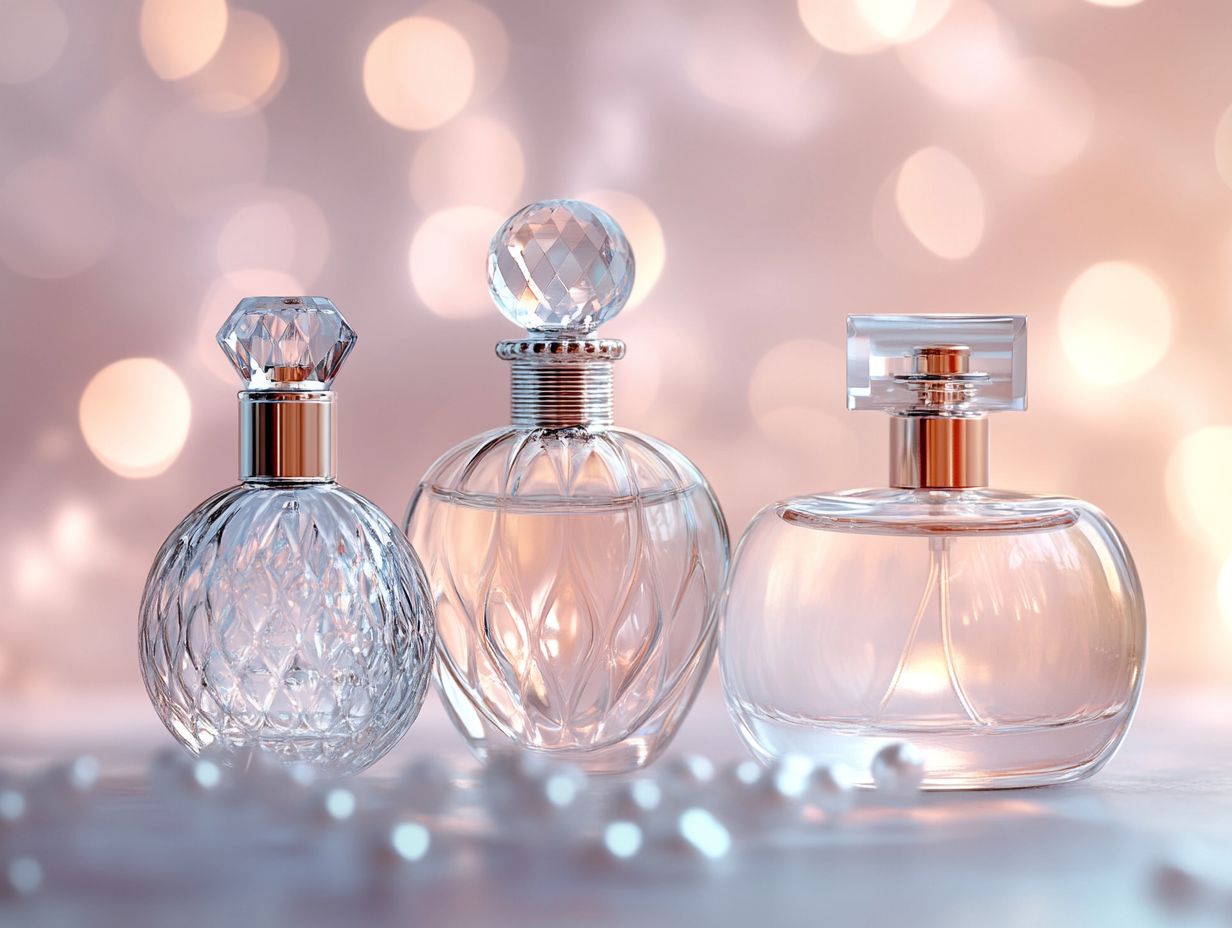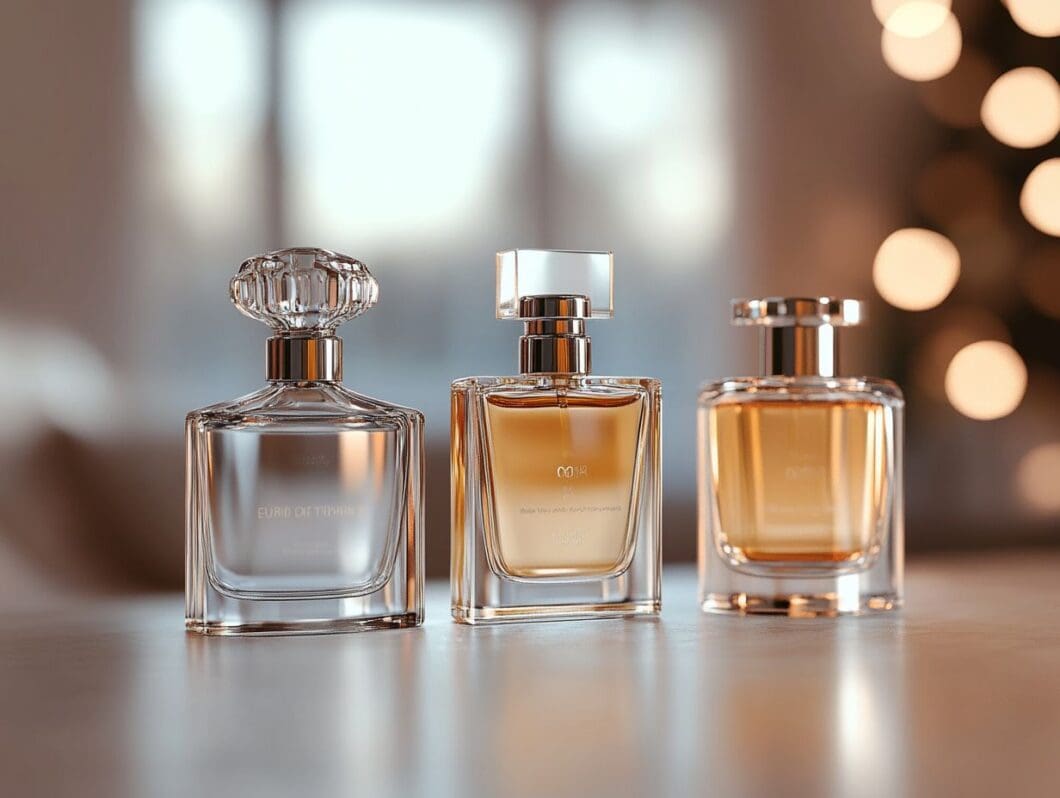Perfume is more than just a pleasant scent; it’s an expression of personality, mood, and occasion.
Whether you’re drawn to the rich depth of Eau de Parfum or the lighter touch of Eau de Toilette, understanding these fragrances can elevate your daily routine.
This piece breaks down the distinctions between the two, helping you choose the right scent for any moment.
Additionally, tips on how to apply your fragrance for maximum impact will be shared.
Get ready to discover the art of fragrance!
Key Takeaways:

What is Perfume?
Perfume is a sophisticated amalgamation of aromatic essential oils, fragrance components, and various other ingredients meticulously crafted to produce a distinctive olfactory experience. It serves as a reflection of personal identity and mood, significantly influencing cultural expressions and individual preferences.
Perfumes are classified into categories such as eau de parfum, eau de toilette, and eau de cologne, with each type varying in fragrance concentration and longevity. The art of scent development requires a comprehensive understanding of base notes, top notes, and overall composition to create a harmonious scent experience that endures on the skin and leaves a lasting impression.
Definition and Characteristics

Perfume is defined as a composition of fragrant essential oils and aroma compounds, specifically crafted to provide an enjoyable scent experience upon application to the skin.
A thorough understanding of the characteristics that distinguish various types of fragrances can significantly enhance the selection process. For example, the longevity of fragrances can differ considerably; some perfumes may last only a few hours, while others can persist throughout the day.
Body chemistry is a critical factor; the manner in which a scent interacts with an individual’s skin can modify its aroma, occasionally transforming a favored fragrance into something unforeseen.
Familiarity with fragrance terminology, including terms such as notes, sillage, and accords, equips consumers to make well-informed decisions. This knowledge ultimately facilitates a more gratifying olfactory experience that aligns with their personal style.
Eau de Parfum vs. Eau de Toilette
Eau de parfum and eau de toilette are two widely recognized categories of perfumes that primarily differ in their fragrance concentration and longevity. These variations influence the manner and context in which they are worn.
Key Differences in Concentration and Longevity

The primary distinctions between eau de parfum and eau de toilette pertain to their fragrance concentration and longevity, with eau de parfum exhibiting a higher concentration and a longer-lasting scent. For more information, check out this article on Understanding the Difference Between Perfume, Eau de Parfum, and Eau de Toilette.
This concentration significantly influences the scent profile and the duration for which the fragrance remains detectable on the skin. For instance, Chanel’s Coco Mademoiselle, categorized as an eau de parfum, features a sophisticated blend of citrus and floral notes that can endure for up to eight hours, thereby captivating both the wearer and those in proximity. Conversely, Dior’s Sauvage Eau de Toilette offers a fresher, more vibrant scent that typically lasts around four to five hours.
Consequently, individuals seeking a more enduring fragrance experience may prefer the concentrated formulations of eau de parfum, while others might be drawn to the lighter, more transient qualities of eau de toilette.
When to Choose Eau de Parfum
Selecting eau de parfum is particularly suitable for formal occasions, evening events, or instances when one aims to make a lasting impression, due to its higher concentration of fragrance oils.
Occasions and Personal Preferences

Eau de parfum is frequently selected for special occasions or moments when individuals seek to enhance their fragrance experience and cultivate a memorable atmosphere. For more information, you can read about the differences in fragrance types here.
For example, during romantic dinners, the rich and complex notes of this type of fragrance can evoke emotions and elevate the overall mood, rendering the evening truly unforgettable. Similarly, at corporate events where first impressions are crucial, a thoughtfully chosen eau de parfum can convey confidence and professionalism, subtly influencing the dynamics of networking.
It is essential for individuals to align their personal preferences with the characteristics of the fragrance; this alignment not only boosts self-assurance but also enhances interactions with others, creating an ambiance that resonates with authenticity and charm.
When to Choose Eau de Toilette
Eau de toilette is an appropriate selection for casual outings and warm summer days due to its lighter fragrance profile and refreshing scent experience.
Occasions and Personal Preferences
Eau de toilette is frequently chosen for everyday wear due to its fresh composition, which provides an uplifting and energizing effect suitable for a variety of occasions.
When evaluating personal preferences, the selection of a scent can significantly impact one’s experience, whether in a busy work environment or during a vibrant social gathering. For example, a light citrus fragrance may be particularly appropriate for an office setting, fostering a welcoming atmosphere without overwhelming colleagues. In contrast, a deeper, more sensual scent may be more suitable for evening events, enhancing the overall mood of the occasion.
By carefully selecting a fragrance that aligns with both the setting and personal style, individuals can elevate their daily experiences, thereby making each interaction more memorable and enjoyable.
Making the Most of Your Fragrance
To maximize the effectiveness of a fragrance, it is essential to understand proper application techniques and storage methods. These practices are crucial for maintaining the fragrance’s integrity and enhancing its scent development.
Application Techniques and Tips
Effective fragrance application entails targeting pulse points, which allows the scent to interact with individual body chemistry, resulting in a more personalized olfactory experience.
This involves focusing on areas such as the w wrists, behind the ears, and the neck, where the skin’s warmth aids in diffusing the fragrance. Utilizing perfume oil can further enhance this experience, as its oil-based formulation typically lasts longer on the skin compared to traditional spray fragrances.
Understanding how individual body chemistry influences scent projection can refine the application process. For example, individuals with oilier skin may observe that fragrances bloom more vibrantly, making lighter application advisable, whereas those with drier skin may benefit from layering techniques to maintain longevity and optimal scent diffusion throughout the day.


